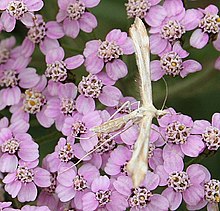Hellinsia osteodactyla
Hellinsia osteodactyla is a moth of the family Pterophoridae. It is found in most of Europe (except the Benelux, Iceland, Ireland and Greece), as well as North Africa and from Asia Minor to Japan. Also known as the small golden-rod plume it was first described by Philipp Christoph Zeller in 1841.[1]
| Hellinsia osteodactyla | |
|---|---|
 | |
| Scientific classification | |
| Kingdom: | Animalia |
| Phylum: | Arthropoda |
| Class: | Insecta |
| Order: | Lepidoptera |
| Family: | Pterophoridae |
| Genus: | Hellinsia |
| Species: | H. osteodactyla |
| Binomial name | |
| Hellinsia osteodactyla (Zeller, 1841) | |
| Synonyms | |
|
List
| |
The wingspan is 16–23 millimetres (0.63–0.91 in). Adults are on wing at dusk in July and come to light.[2]
The larvae feed on the flowers and seed-heads of European goldenrod (Solidago virgaurea), Senecio nemorensis, silver ragwort (Senecio bicolour) and goldilocks aster (Aster linosyris).[3]
References
- "Hellinsia osteodactylus (Zeller, 1841)". Fauna Europaea. Retrieved 15 August 2020.
- Kimber, Ian. "Hellinsia osteodactylus (Zeller, 1841)". UKmoths. Retrieved 15 August 2020.
- Ellis, W N. "Hellinsia osteodactylus (Zeller, 1841) small golden-rod plume". Plant Parasites of Europe. Retrieved 15 August 2020.
This article is issued from Wikipedia. The text is licensed under Creative Commons - Attribution - Sharealike. Additional terms may apply for the media files.